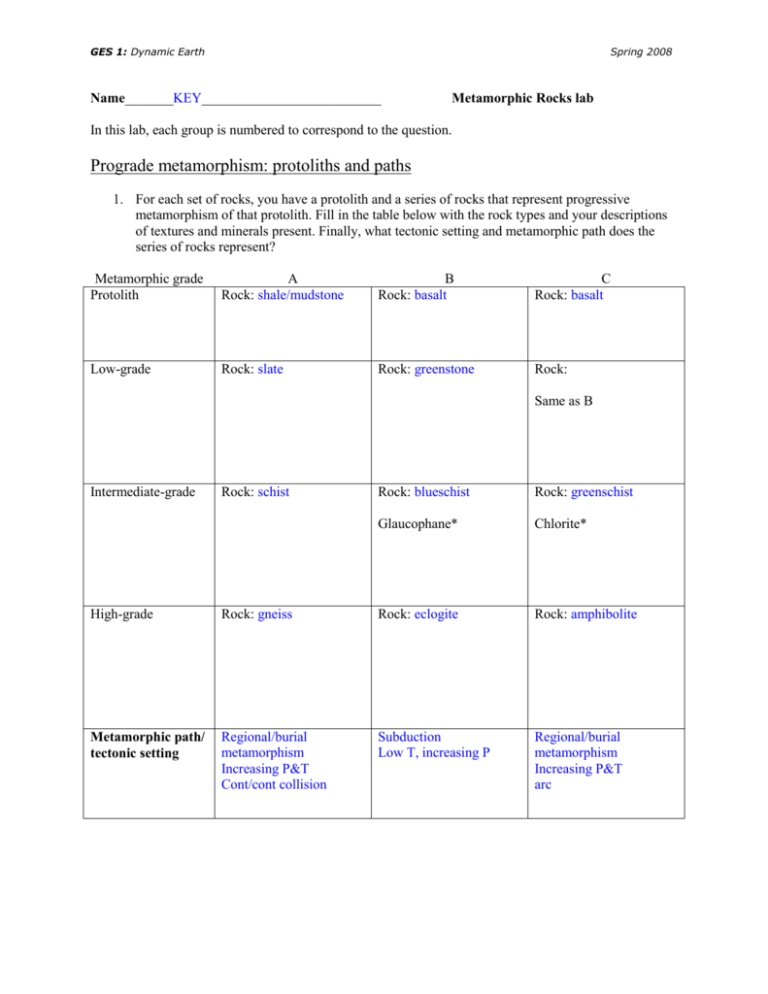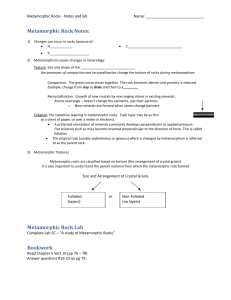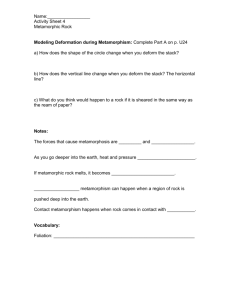KEY - Cloudfront.net
advertisement

GES 1: Dynamic Earth Spring 2008 Name_______KEY__________________________ Metamorphic Rocks lab In this lab, each group is numbered to correspond to the question. Prograde metamorphism: protoliths and paths 1. For each set of rocks, you have a protolith and a series of rocks that represent progressive metamorphism of that protolith. Fill in the table below with the rock types and your descriptions of textures and minerals present. Finally, what tectonic setting and metamorphic path does the series of rocks represent? Metamorphic grade Protolith A Rock: shale/mudstone B Rock: basalt C Rock: basalt Low-grade Rock: slate Rock: greenstone Rock: Same as B Intermediate-grade Rock: schist Rock: blueschist Rock: greenschist Glaucophane* Chlorite* High-grade Rock: gneiss Rock: eclogite Rock: amphibolite Metamorphic path/ tectonic setting Regional/burial metamorphism Increasing P&T Cont/cont collision Subduction Low T, increasing P Regional/burial metamorphism Increasing P&T arc GES 1: Dynamic Earth Spring 2008 Metamorphic textures In the first part, you saw some good examples of foliation. Write or draw a definition of foliation here: The planar texture of a rock. Comes from the Latin folium, leaf. Now let’s look at some other metamorphic textures: 2. Here are two rocks, one you’ve seen before – it’s an igneous rock called diorite, and it is the protolith of the other, which is a metamorphic rock. Describe how the texture changed during metamorphism. How is this metamorphic texture different than foliation? The igneous texture of the diorite has random interlocking crystals, the metamorphic texture has an orientation to it. While foliation is a planar texture, this rock has minerals (hornblende especially) that are arranged in lines. This texture is called: lineation 3. Describe the differences and similarities between these two rocks. One is conglomerate, the other is a metamorphosed version of conglomerate. What do you think caused the changes? Differential stress caused stretching of the originally spherical pebbles in the conglomerate. 4. This metamorphic rock contains a new mineral – the dark red crystals are garnet* (a silicate mineral in the olivine family). How does the metamorphic texture of this rock compare to the others? Why? Random texture, no foliation or lineation because it wasn’t subjected to differential stress. This rock is a very pretty example of: hornfels; high T, low P metamorphism (contact) metamorphism 5. Here’s a porphyritic igneous rock (meaning it has big crystals in a fine-grained groundmass). The other is a metamorphic rock. There is a new mineral in this rock – the big crystals are a silicate mineral called andalusite*. How does this texture compare to the igneous one? What might cause this texture in a metamorphic rock? Similar; large crystals in a finer-grained background. Right conditions for andalusite to grow while the rest of the rock remains fine-grained. GES 1: Dynamic Earth Spring 2008 More protoliths In the first section you looked at some metamorphic products of mudstone and basalt. Here you will examine what some other rock types look like when metamorphosed. 6. Describe the differences and similarities between these two rocks. One you should be pretty familiar with – it’s sandstone. The other one is the metamorphosed version of sandstone, called quartzite. What changes have taken place during metamorphism? Recrystallization, interlocking crystalline texture forms, increase in density, can’t see sand grains anymore. 7. Here’s another quartzite. How does it compare to the quartzite in number 6 in terms of both texture and composition (remember composition means what minerals are present)? Why might this one look different? Foliated (6 was not); not just quartz, there is some muscovite too indicating that the sandstone had some other minerals in it. Texture results from differential stress; we can see it because there are other minerals to define the layers. 8. Describe the differences and similarities between these two rocks. One you’ve seen before – it’s limestone. The other one is the metamorphic version of limestone called marble. What changes have taken place during metamorphism? Recrystallization, interlocking crystalline texture forms, increase in density, can’t see sand grains anymore. Same idea as quartzite. 9. You’ve seen both of these before – the protolith is peridotite, the other is serpentinite (which is made almost entirely of the mineral serpentine*). How do these rocks compare chemically? Hint: look at the formulas for the minerals present in each rock. I gave you serpentine in the table. First of all, peridotite is a rock composed of olivine and pyroxene. Same composition with the big difference being the presence of the OH group in serpentine. What causes metamorphism of peridotite to serpentinite? When water is added to peridotite, the minerals become unstable and change to serpentine. This happens in the mantle wedge above the subducting oceanic crust. 10. This sample is another gneiss. What is the most likely protolith for this rock? Hint: what minerals are present? Hornblende, alkali feldspar, quartz, some have biotite. We can’t be totally sure since the metamorphic grade is so high; any indication of original textures are long gone. We can say, however, that whatever its protolith was, it had a composition very similar to granite so it’s a good guess. GES 1: Dynamic Earth Spring 2008 Not so tricky question… 11. These two metamorphic rocks look very similar, but they are, in fact, different rocks. What are they, and how do you know? Quartzite and marble; marble is composed of calcite which fizzes in HCl. Metamorphic minerals If you haven’t yet, go look at the mineral boxes and complete the table. You should be able to say something about the metamorphic conditions they grow under based on your observations of the rocks. Keep in mind that some minerals are stable over a broad range of conditions while others are more restricted. Kyanite* and andalusite* have very different crystal forms, but have the same chemical composition. Why might they have different crystal forms? They are stable at different metamorphic conditions. Summary Metamorphic rocks can be very confusing because of the seemingly infinite combination of physical and chemical conditions possible. This is also why they are exciting! They give us a unique window to the past; one rock can tell a big story. Here are some ways to think about metamorphic rocks that may help simplify things. Metamorphic textures depend primarily on: 1. Stress conditions; uniform or differential? (2. Grain size can also reflect temperature conditions in some cases…higher T, bigger crystals) Why are metamorphic textures useful? What do they allow us to figure out? They allow us to identify ancient stress conditions, which reflect tectonic setting and the relative direction of plate motions. The metamorphic minerals present are a function of: 1. Composition of the protolith 2. Pressure 3. Temperature Why is identifying metamorphic minerals useful? What information can we get from knowing what minerals are present in a metamorphic rock? We can often constrain the P&T conditions of metamorphism by the minerals present. Sometimes we can also identify the protolith.









